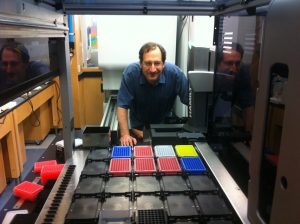A comprehensive UC San Francisco-led study flagged drug components in need of more rigorous review to be sure they are safe. The UNC School of Medicine lab of Bryan Roth, MD, PhD, conducted important screening studies to confirm the findings.

Some supposedly inert ingredients in common drugs — such as dyes and preservatives — may potentially be biologically active and could lead to unanticipated side effects, according to a preliminary new study by researchers from the UC San Francisco School of Pharmacy and the Novartis Institutes for BioMedical Research (NIBR). The National Institute of Mental Health’s Psychoactive Drug Screening Program housed at the UNC School of Medicine and led by Bryan L. Roth, MD, PhD, provided essential confirmatory data for this paper published in Science.
Most medications include only a relatively small amount of their active pharmaceutical ingredient by mass (for instance, the acetaminophen in Tylenol and other medications). The rest of any given pill, liquid, or injectable can be composed of ingredients including preservatives, dyes, antimicrobials and other compounds known as excipients. These ingredients play critical roles in making sure a drug’s active ingredient is delivered safely and effectively, as well as conferring important qualities like shelf stability and the ability to quickly distinguish pills by color.
Excipients are generally accepted to be biologically inactive based on their long history of use, or because they don’t produce any obvious toxicity in animal studies. But few studies have looked for more subtle effects of long-term exposure to these compounds or how they might interact in people who take multiple different medicines that include these ingredients.
Researchers Brian Shoichet, PhD, of the UCSF Department of Pharmaceutical Chemistry, and Laszlo Urban, PhD, Global Head of Preclinical Safety Profiling at NIBR, wondered if these substances were really inert and joined forces to investigate them. Beginning in 2017, they began documenting most readily accessible pure excipients, which the UCSF group had compiled in an easy-to-use excipients browser, itself drawing on a more specialized FDA inactive ingredients database (IID), with support from the FDA-funded UCSF-Stanford Center of Excellence in Regulatory Science and Innovation (CERSI).
As reported in their new Science study, the researchers have now systematically screened 3,296 excipients contained in the inactive ingredient database, and identified 38 excipient molecules that interact with 134 important human enzymes and receptors.
The research team emphasizes that their study, which did not look for actual effects on human patients, is only intended to flag molecules with the potential to pose negative health effects, and the examples they list will need to be further studied to understand how they might contribute to side effects of drugs in which they are found.
“These data illustrate that while many excipient molecules are in fact inert, a good number may have previously unappreciated effects on human proteins known to play an important role in health and disease,” Shoichet said. “We demonstrate an approach by which drug makers could in the future evaluate the excipients used in their formulations, and replace biologically active compounds with equivalent molecules that are truly inactive.”
The team used a couple of different approaches. At UCSF, Shoichet’s team computationally examined excipient molecules that physically resemble the known biological binding partners of 3,117 different human proteins in the public ChEMBL database. The team then computationally pared down 2 million possible interactions of these excipients and human target proteins to 20,000 chemically plausible interactions.
Based on visual inspection, the researchers identified a subset of 69 excipients with highest likelihood of interacting with human target proteins, and tested these interactions experimentally in laboratory dishes, in collaboration with the groups of Bryan Roth, PhD, the Michael Hooker Distinguished Professor of Pharmacology at the UNC School of Medicine, and Kathy Giacomini, PhD, a professor of bioengineering at UCSF and co-director of the UCSF-Stanford CERSI center.
These experiments identified 25 different biological interactions involving 19 excipient molecules and 12 pharmacologically important human proteins.
In a complementary set of experiments at NIBR, the researchers screened 73 commonly used excipients against a panel of human protein targets involved in drug-induced toxicity and regularly used to test drug candidates for safety. They identified an additional 109 interactions between 32 excipients and these human safety targets.
“Our study was meant to expand on anecdotal evidence that excipients may be the culprits of unexpected physiological effects seen in certain drug formulations,” said study lead author Joshua Pottel, PhD, a former postdoctoral researcher in the Shoichet lab who is now President and CEO of Montreal-based Molecular Forecaster Inc. “It was not so surprising to find new properties of understudied compounds that have been grandfathered in as ‘inactive’ for decades, but it was surprising to see how potent some of these molecules are, especially considering the fairly high quantities sometimes used in typical drug formulations.”
The biologically active excipients the study identified in laboratory dishes merit further study in animal models to establish whether any of them may in fact produce unwanted side effects in human patients, the authors said. Many should be readily interchangeable with truly inert excipients of similar function, they said, but for others, new replacement compounds may need to be developed.
Joshua Pottel, formerly of UCSF, is the study’s lead author. Brian Shoichet of UCSF and Laszlo Urban of NIBR are joint corresponding authors.
The research was supported by US National Institutes of Health (NIH) grants GM122481 and GM71896, the National Institute of Mental Health (NIMH) Psychoactive Drug Screening Program, and FDA grants U01FD004979 and U01FD005978 which support the UCSF-Stanford Center of Excellence in Regulatory Sciences and Innovation.
Nicholas Weiler at UCSF wrote this news release. The UNC School of Medicine contact is Mark Derewicz.